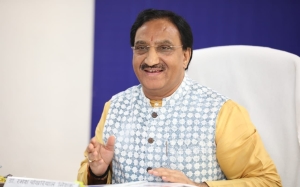
Associate Project Director – School Governance, CSF
Q1. The Indian education system has successfully achieved near-universal enrolment in primary grades. However, we are far below universal student learning. Why do you think this dichotomy exists?
Given the complexities of a large country like India, we have multiple educational priorities that can hinder us from achieving our goals. Despite that, we achieved the enrolment target because the government had set it as a dedicated goal for K-12 school education. The Sarva Shiksha Abhiyaan was introduced in 2001 by the Government of India and the constitutional introduction of Article-21A in 2002 made free and compulsory elementary education (for children aged 6 to 14 years) a fundamental right. One of the Supreme Court interventions led to a nationwide expansion of the mid-day meal scheme in the same year. These inspired all other subordinate authorities to also work towards enhancing school enrolment through various synchronised initiatives. As a result, parents were instantly convinced to enrol their children in schools. With this single-minded focus and early wins, the enrolment ratio spiked and in 2004, our gross enrolment ratio (GER) in primary grades crossed 100%. Later, in 2009, a parliamentary act reinforced the right to education for children in elementary grades.
The problem of getting out-of-school children to enrol was significantly solved between 2002 and 2010, after which we improvised by addressing school absenteeism and dropouts. The objective of increasing enrolment has been taken on as a mission in the last two decades. However, the goal of student learning achievement has yet to be elevated to that level. While we acknowledged our children’s right to education, we could do better to ensure quality education for them. The graph of learning levels for our students has largely been flat from 2011 until today. Our focus on outcomes in the New Education Policy (NEP) 2020 and subsequent programmatic goals like NIPUN Lakshyas are praiseworthy, however, their awareness can be improved to make them mainstream. External nudges like the United Nations SDG4’s call to focus on student learning or events like India’s performance in PISA in 2009 only occasionally highlight the problem.
A consistent environment that makes our system prioritise student learning is what we need. This requires us to rethink our governance actions to ensure that all stakeholders, including parents, teachers, school management, third-party service providers, parliament and state legislatures, education quality auditors and accreditors, state education departments and ministry officials, remain committed to making quality student learning a reality in the country.
Q2. NEP 2020 talks about a State Schools Standards Authority (SSSA) and underpins its role in driving a competency-based State Assessment Survey (SAS) in every school to improve educational outcomes. What could be their impact on school governance?
If a parent is being made to send their child to a school for multiple years, they deserve to know the information about that school. Schools usually reveal their fees & facilities and then add those elements they want to market. Government schools are also marketing themselves these days and attracting parents for enrolment in their limited ways. However, student learning performance is conspicuously absent from this marketing message from either type of school. What should be the raison d’être of a school is nowhere in the discourse. Closest to their performance on student learning is the school’s results in board examinations and selection of their students in the competitive exams, if the school considers it worthy of being told. But this is not a surefire way of knowing their accurate picture or to draw comparisons between schools, particularly in the early grades. Keeping this mind, there should be some higher authority that can set the standards for visualising school performance. Similar to quality benchmarks for appliances, hotels, jewellery, etc., there should also be a comparable rating for school quality. You might ask, which expert body should be rating these schools? How can we ensure its fairness across all kinds of schools (government and private)? How will the standards be decided? How do we ensure that the rating considers the achievement of student learning outcomes?
NEP 2020 talks about a school regulator called the State School Standards Authority (SSSA), to set standards and publicise the level of each school in the state based on those standards; these school could either be public or a private. As a parent, you can see verified and comparable quality information about all the schools nearby. If the state government can aggregate the same information at a panchayat, district, or state level, it can serve multiple purposes of system diagnosis and make the relevant stakeholders answerable. An authority that facilitates disclosure in the sector can solve many prevalent problems manifesting due to a lack of transparency and accountability.
Cost-wise, these initiatives will help schools prioritise and route their investments to enhance student learning rather than add embellishments that unnecessarily increase the cost of education for a child. Often, schools undertake projects to enhance the infrastructure or buy equipment with good optical value but no proven impact on student learning. Since there is no specific demand from the system, it tends to invest in whatever feels right at the moment, but here, due to a demand for learning, the system would invest in improving learning.
With this change, newer schooling models may emerge showing substantial changes in student learning outcomes with incremental inputs. Such initiatives can be appraised and replicated to promote evidence-based decisions and investments across the country.
Q3. What is CSF’s approach to implement reforms, mentioned in NEP 2020, that make schools accountable for learning?
CSF works as a catalytic enabler in a few states to implement the reforms suggested by NEP 2020. We focus on:
- Supporting the creation of an independent school regulator called the State School Standards Authority (SSSA) by providing design inputs and broader stakeholders’ perspectives to Assam and Uttar Pradesh.
- Working with the Government of Rajasthan and Gujarat to implement standardised assessments at key stages (Grades 3, 5 and 8 as per NEP 2020) to measure student competencies across all schools as a marker of their learning quality. This helps generate school-level reports that help parents make informed choices/decisions on schools their children go to.
- Developing public goods to raise awareness about school reforms.
Q4. What can be some of the most high-leverage measures to enhance student learning outcomes in India?
The simplicity of the demand-supply concept can explain and shape some complex behaviours. If sufficient demand and supply co-exist, anything can be attained, including student learning outcomes.
When the National Achievement Survey’s (NAS) results were published in 2017 and 2021, civil society organisations (CSOs), educationists, media, and other stakeholders started demanding better results from the system, states and districts, as the district was the micro-unit of reporting in NAS. This made them accountable for better learning outcomes. As a result, several initiatives were undertaken by the states and districts to improve in the subsequent NAS rounds.
Let us extend this to schools and consider that the student is our end-consumer for K-12 education. Their parents, as customers of the school education system, must demand quality education on their behalf. Since parents are unlikely to use a district or a block report and demand action, they can be empowered to demand quality from their schools, whether private or public. A simple activity of measuring student learning performance, if extended to publish the quality level for every school in a state while keeping the student data anonymised, can activate the parent demand for quality in school operations. They may be encouraged to take more interest in the teaching-learning processes impacting their child. Schools doing exceptionally well, while being similarly resourced, will emerge as exemplars and best practices can be replicated across the state. This may lead to parents choosing the best nearby school for their children and voting with their feet, giving them a novel agency that makes the system accountable to their needs.
On the supply side, we can open up the sector and allow more schools to enter by reducing the regulatory barriers without compromising on quality standards. Currently, private schools are required to cater to the many restrictive requirements of the state education departments and the boards of assessments, like the existence of a playground, one room per teacher, reserving a specific percentage of fee receipts for teacher salaries, etc. Breaking down these barriers can spur the opening of more schools, promote competition, reduce pricing, allow our parents to access a variety of schools to choose from and incentivise quality improvement. The regulatory criteria can also be re-engineered to allow for transparent disclosure of the performance of schools on various standards, supporting the demand generation explained above to ensure that the quality remains high for all schools.
Q5. Highlight some exemplary global models of school quality transparency. Do you think they can be contextualised for India? If yes, how?
There are some excellent examples of school quality transparency models from across the world – Sistema de Medición de la Calidad de la Educación (SIMCE) in Chile, Knowledge and Human Development Authority (KHDA) in Dubai and Office for Standards in Education (Ofsted) in the United Kingdom (UK).
- SIMCE is Chile’s national assessment system for evaluating school educational quality. It conducts standardised tests across different grade levels and subjects. The results inform parents, guide educational policies, and support interventions for underperforming schools.
- KHDA is the regulatory body responsible for overseeing private schools in Dubai. It conducts regular inspections and assessments of schools, rating them on various parameters such as student achievement, teaching quality, and leadership. These ratings are made public, empowering parents to make informed choices.
- In the UK, Ofsted is the non-ministerial government department responsible for inspecting and regulating services that care for children and young people, including schools. Ofsted’s inspections cover a wide range of aspects, including the quality of teaching, leadership and student outcomes. Their reports are available in the public domain.
While these systems have proven effective in their respective contexts, it is essential to recognise that India’s education landscape presents unique challenges and opportunities. With half the students enroled in government and half in unaided or aided private schools, an unbiased regulatory authority should include representatives from all school types. Given India’s size and complexity, implementing comprehensive quality measurement systems like those in other countries may be challenging initially. Therefore, defining a minimum viable product or a minimal set of standards that focus on core parameters related to student learning and school outcomes’ quality would be prudent. An initial phase could establish a baseline by collecting basic safety and hygiene data, key student learning indicators and teaching impact. Once this foundation is laid, we can embark on an iterative process of refining and expanding the definition of school quality. Transparency in the disclosure of learning outcomes for every school in India can pave the way for better, meaningful discussions and sustainable interventions to improve school quality.
About Kapil Khurana
Kapil works as an Associate Project Director in the School Governance team at CSF. He started his career as a teacher and content writer and progressively moved to leading sales and business transformation in the Fast-Moving Consumer Goods (FMCG) and Pharmaceuticals sector. He also founded an EdTech business on teaching improvement that impacted 8,000 school teachers and over 2,00,000 learners in early childhood and elementary grades across India and the Middle East.
Kapil is passionate about impacting learning outcomes in schools. Having invested most of his career in education in K12 schools, he conceptualised and led programmes improving foundational learning for children in India.
Kapil holds a Master’s degree in Business Management from IIM-Lucknow and a Bachelor’s degree in Computer Sciences from Delhi University.



